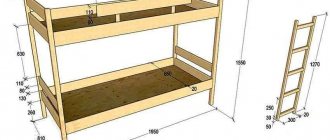Often, when renovating a kitchen, a dishwasher is installed along with the kitchen unit. At this stage, it is ensured that it will fit perfectly and that all the necessary hoses and electricity will be connected to it. In the future, you won’t need to modify anything; the cabinets can be safely filled with food and kitchen utensils.
However, sometimes the purchase of a dishwasher is postponed to a later date. In this case, there is a need to make changes to the design of the existing kitchen, that is, install a dishwasher (DMM) in a ready-made unit where there is no space provided for it.
A dishwashing machine is no longer a whim or a luxury item, but a time-tested home assistant that has been tested by hundreds of housewives. The PMM consumes a very small amount of water and electricity, takes up fairly little space, works quietly and, most importantly, frees up a lot of time for other things.
So, you decided to take a step with the times and are about to buy a dishwasher. Where to begin?
We understand the types of dishwashing equipment
These days, dishwashing machines come in many variations. They come in different sizes, colors and configurations. Some of them are truly amazing in functionality.
All modern dishwashers can be divided into 4 groups, based on the installation method:
- Freestanding . This is a fairly common option because adding a separate machine to the kitchen does not require modifying or rearranging cabinets. It can be placed in any free space if the area of the room allows it. Freestanding equipment is easier to connect and maintain. Another advantage is the lower price.
- Embedded . As a rule, such models are rolled in or pushed under the tabletop. From the outside, the machine door and its control panel are completely visible. Or you can install a front panel of the same color or completely the same as on the cabinets around, which will hide the PMM. This option is rarely used for installation in a ready-made kitchen.
- Semi-integrated . This type is more invisible in the interior; only the bar with the keys is visible from the outside. The decorative façade allows access to selecting and launching a work program.
- Fully integrated . This installation option makes it impossible to understand without opening the door that there is some kind of equipment behind it. If the appearance of the kitchen is such that the symmetry of the cabinets or other considerations do not allow changing the appearance from the outside, then it is best to use this method.
Usually, attempts to figure it out begin with a choice between a free-standing one and one of the built-in ones. The latter often have more features and settings. For example, a mode for washing pans with burnt food or an increased number of water nozzles.
Among free-standing PMMs, they are less common, but there are also more advanced ones. For example, some of them can automatically determine the amount of loaded dishes and have complex operating programs that include several washing cycles.
What types of built-in dishwashers are there?
There are two options - partially built-in and fully built-in. Let's take a closer look at each option.
Fully built-in
The fully built-in device is installed in the headset niche. Its top is covered with a tabletop, and on the door there is a hinged facade made of a material similar to that from which the furniture is made. If you close the door, you won’t realize that there’s a hefty dishwashing machine hidden behind it. This is the main difference between built-in and non-built-in PMM. Advantages of fully built-in devices:
- Allows you to create a holistic design in the kitchen.
- The equipment is hidden, which means child interference is prevented.
- They are believed to be quieter. But this is a subjective opinion.
There is only one drawback to such dishwashers - you can’t place them wherever you want, you must fit them into the kitchen furniture. Why? They do not have decorative side panels. The second reason is that the door does not lock in the open position or is difficult to open if the front is not hung. Separately, without placing it in a closet, it is impractical to install such a device.
Partially recessed
They differ from fully built-in ones in the location of the control panel - it is located on the top of the door. Below the panels, hang the front part of the set or a decorative panel that matches the color. Why is this done? Many people care about how their equipment looks in the interior. Users find it strange to hide stylish equipment in a closet. Why not show it off? Partially built-in PMMs are an option when the equipment is slightly visible and harmony is maintained.
Built-in dishwasher versus separate
To choose a fundamental side in this issue, it is better to just remember the main differences for now, and then use this data in the next stages.
Any built-in appliances often remain in the original kitchen along with the furniture when moving. And a separate dishwasher can follow suit.
If you are considering the option of not trying to fit the dishwasher into the cabinet, also think about the fact that you will have more storage space , because you will not need to lose the existing space to place a new device in it.
In contrast, compact, freestanding dishwashers require no space inside cabinets but do take up counter space . In cases where the work surface is already overflowing with jars of seasonings, a cutting board, a slow cooker, a toaster and other items and devices, the extra equipment will really become superfluous.
In small rooms, an abundance of objects on tables creates a feeling of clutter and visually reduces the space. The good thing about built-in appliances is that they are either not visible at all, or simply do not protrude, stand flush with the facades of the furniture, and never interfere with the passage.
Typical sizes of dishwashing machines
The standard size of a dishwasher is: width 60 centimeters (same as ovens), height 82 centimeters and depth 60 centimeters . There are also models in other sizes.
Due to the variety of options, as well as restrictions in the form of strictly defined sizes of possible placements in your kitchen, it is extremely important to take measurements and carefully study the descriptions of the machines. If the room has a small area, then you need to measure and read even more carefully.
When looking for a place for a dishwasher, pay attention to the free space of the work surface. There are many compact models that can be installed in any place where you could, for example, place a multicooker. That is, a small part of a table or cabinet is enough for them. The main condition for installation is access to water and power.
For orientation, we will name the size limits for various PMM models. They can vary in width from 45-50 (compact) to 80 centimeters (wide) . Full-size cars do not vary too much in height - from 80 to 88 centimeters.
There is a class of units built into cabinets called low units. Their height is up to 45 centimeters . A significant advantage of these models is the possibility of installation under the sink or combined in one cabinet with a drawer for storing dishes.
Just like other appliances: refrigerators, ovens, air conditioners and others, a dishwasher requires space for proper ventilation and cooling . These requirements may vary for different models.
Model overview
Let's look at the models of built-in dishwashers that are chosen by domestic consumers.
Electrolux ESL 94200 LO
Electronically controlled model. The noise is moderate - 51 dB. Five washing programs and 3 temperature settings. There is a drying function - condensation type. In addition to the standard set of programs, there is soaking and washing of lightly soiled dishes. Specifications:
| Type | narrow |
| Installation | fully built-in |
| Capacity, sets | 9 |
| Energy consumption | A |
| Washing/drying | A/A |
| Water consumption per cycle, l | 10 |
| Dimensions, cm | 45x55x82 |
| Weight, kg | 30,2 |
| Cost, rubles | 17 000 |
Owner reviews are mostly positive. They praise the machine for its high-quality washing, and also note the following advantages:
- complete protection against leaks;
- the inner surface of the chamber is made of stainless steel;
- The dish basket is height adjustable;
- A glass holder is provided.
Noticed shortcomings:
- no clean water sensor;
- there is no automatic determination of water hardness;
- no half load;
- not spacious enough;
- too noisy.
Bosch Serie 2 SMV24AX02R
Electronic control. A typical program lasts 210 minutes. Noise - 52 dB. 4 programs and 2 temperature settings. Drying - condensation. There are special programs for fragile dishes and an economy wash. You can use the “3 in 1” product.
| Type | full size |
| Installation | fully built-in |
| Capacity, sets | 12 |
| Energy consumption | A |
| Washing/drying | A/A |
| Water consumption per cycle, l | 11,7 |
| Dimensions, cm | 59.8x55x81.5 |
| Weight, kg | 30 |
| Cost, rubles | 24 000 |
The owners noted the following advantages:
- half load;
- completely protected from leaks;
- there is a delayed start timer - up to 9 hours;
- there is a holder for glasses;
- indicator on the floor - beam.
Flaws:
- no child protection;
- no automatic hardness setting;
- no display;
- too noisy;
- short hoses - you have to extend them.
Capacity, loading volume
The capacity of the PMM is usually measured in sets of dishes that can be placed there. What is included in one such set: a soup plate, two flat plates (for the second and a dessert plate), a cup, a saucer and cutlery for them. The larger the capacity, the more efficient the dishwasher will be.
Once you get used to the method of determining load by the number of sets, it will be very easy to choose a work program for your new assistant.
Built-in full-size models are often more spacious than freestanding or compact ones. They can simultaneously wash up to 12-14 sets of dishes . They are ideal for the kitchen of any family where more than 2-3 people constantly live and dine. Miniature models have a capacity of 6-8 sets .
When choosing a dishwasher, try to calculate how often and how many dishes and other items you will need to wash at a time. Some people have to start the car every day, while others get by with only a couple of starts a week.
The size of the cutlery holder, as a rule, corresponds to the number of cookware sets declared by the manufacturer. In some machines, the holders are divided into several and have special fastenings for different types and sizes of spoons, forks and other things.
The more often you use your dishwasher, the more important it is to choose the most energy-efficient model .
The most efficient machines are rarely cheap, but can save you from high electricity bills in the long run, especially if you plan to use them quite often.
Criterias of choice
Let's look at how built-in dishwashers can differ and how to choose the optimal model for your home.
Dimensions
All modifications - fully and partially built-in - are divided into:
- Full size. Width and depth are 60 cm each. 82 cm is height.
- Compact. Width - 45 cm, depth - 50 cm, height - 40 cm.
- Narrow. Width 45–50 cm, depth 50 cm, height 82 cm.
Capacity
The first aspect that worries any buyer is how many items can the dishwasher wash at a time? When choosing capacity, you need to be guided by the needs of the family - the average volume of dirty dishes and the frequency of washing:
- A standard PMM, designed for 10–14 sets, is suitable for a family of 5 or more people.
- A family of 3-4 people will need a narrow model that can accommodate up to 9 sets at a time.
- For 1-2 people, a small-sized machine is suitable, which can fit no more than 5-6 sets.
What is included in the set according to European standards - three plates, a saucer, a cup, a glass and cutlery - a knife, a fork and three spoons. Read more in the article about the cookware set.
What programs are there?
Any dishwasher has at least four standard programs. But usually modern models have 5–6 modes. Required modes:
- normal;
- intensive;
- express cycle;
- pre-soaking.
The choice of program depends on the type of dishes and the degree of soiling. Expensive modifications often have additional modes, for example:
- washing of particularly fragile products;
- Economy mode for lightly soiled plates;
- bioprogram - it is used in combination with special detergents containing bioadditives that can break down dirt in cold water.
It is convenient if a large PMM provides half loading. This feature will allow you to wash small batches of dishes, saving water and energy.
Choose a device that has many temperature settings. Then each batch of dishes can be washed under optimal conditions. When evaluating equipment according to this criterion, you should not look for an option with a large number of programs - the standard package is enough.
What is the resource consumption?
By purchasing a dishwasher, you will spend not only water on washing dishes and pots, but also electricity. It is clear that there is no need for large expenses. So, pay attention to the efficiency of the car. The water consumption per cycle in normal and economical mode is important.
Devices that consume no more than 15 liters are considered economical. But on the market today you can find modifications with a flow rate of 8–9 liters per cycle. If a device spends 20 or more liters of water per wash, it is considered uneconomical.
Electricity costs depend on water consumption. For example, a PMM, consuming 8 liters, spends 0.62 kW*h, and 12 liters - 0.85 kW*h.
What protection against leaks?
This feature keeps the water in the dishwasher under control. There are two protection options:
- Full. The best models are equipped with it. Provides reliable operation. As soon as the system detects a problem, the water supply will immediately stop if there is excess water and damage to the hoses - a special valve is activated.
- Partial. This protection is used in inexpensive versions. The water supply stops if the pan overflows.
Is it noisy or not?
Nobody likes noisy technology. The cheaper the model, the more noise it makes. The noise generated by the PMM is in the range of 38–55 dB. Recommended:
- If you are going to wash dishes at night, take an option with a noise level of no more than 45 dB - then those who sleep lightly will not be unhappy.
- If you want cheaper equipment, take one with a noise level of more than 45 dB, but it will probably irritate you. Especially if the house is quiet.
Washing quality
This parameter is determined by the washing class. It is assigned based on test results. Classes are designated by Latin letters in alphabetical order. The highest class is under the letter “A”. Next - decline. However, models with classes “B” and “C”, which allow contamination after washing, are rare today. Why buy equipment that doesn’t even promise high-quality cleaning?
What kind of management?
There are two types of control:
- Mechanical. This is a convenient and reliable option. But today it is almost never found.
- Electronic. PMMs with such controls are easy to use; you can quickly select programs and modes.
What kind of drying?
Almost every PMM is equipped with a dryer. There are two types of drying:
- Condensation. The dishes are rinsed with very hot water and then dried.
- Turbo. The fan blows heated air over plates and other utensils. This option is more often used in more expensive machines.
How to install?
The dishwasher kit includes hoses and fasteners. A consumer who has the skills to install washing machines, boilers, boilers or water heaters can easily connect a dishwasher. The connection is made to:
- electricity supply;
- cold water;
- sewerage.
Inexperienced users should not attempt installation themselves. Lack of professionalism will cause equipment failure.
Since the machines are powered by tap water, they have cleaning filters. They need to be cleaned from time to time. If the quality of washing deteriorates, the filters are removed and washed with water and detergent. To make filters and other parts of the device last longer, special water softeners are used.
What else should you pay attention to?
A delayed start timer wouldn't hurt. There are models with a special program for pots - also a useful thing. Dishwashers usually heat water on their own, but there are modifications that can be connected to a centralized hot water supply.
The kit comes with:
- A basket in which cutlery is stored - knives, forks, spoons.
- Funnel - use it to carefully pour in and add liquid and powder detergents.
Functions, capabilities
Most equipment from well-known manufacturers have similar functionality and perform their main duties perfectly. At the same time, some dishwashers have features and additional programs that you may find useful or attractive.
For example, some modern machines work so quietly that you cannot even tell by ear whether it is working now. If your budget allows, take a quiet model . Carefully look at the tables with characteristics or ask sales consultants.
What other options can be found in a dishwasher?:
- Adjustable shelves;
- Additional, replaceable baskets for cutlery;
- Replacement racks for pots and pans;
- Metal racks;
- Various sensors and probes;
- A number of effective programs, for example, rinse only, half load, lightly rinse and so on;
- Digital controls (older or cheaper models have mechanical knobs and buttons);
- Hot water connection, allowing you to wash in hot or cold mode. Washing in cold water takes longer because it needs to be warmed up first;
- Noise insulation, quiet mode;
- Built-in flood protection, in which the machine has a safety valve that shuts off the water supply when the pressure changes at the top of the inlet hose;
- Locking the door and control panel, protecting against children and animals;
- Special drying modes or alerts.
How to connect
Before connecting the machine, you need to do the following:
- place the device near a cabinet or niche, pass hoses through the passages in the walls of the module, pull the power cable towards the outlet;
- push the dishwasher in, trying on the length of the hoses;
- pull out the device and prepare for installation;
- cover the inner surface of the tabletop with waterproofing material;
- cover the edges of the machine with sealing tape;
- give the machine body a level position (to do this, tighten the adjustable legs);
- Attach soundproofing material to the bottom of the dishwasher;
- install decorative facades.
Electricity
Dishwashers are equipped with a power cable 1.5 m long. The distance from the appliance to the outlet should not exceed this figure. The use of network filters and extension cords is undesirable. Powerful household appliances are connected to separate power lines. It will not be possible to embed cables into the walls after assembling the kitchen unit, so they are hidden in boxes.
To install a grounded socket, you will need 2.5 mm thick wires, a 16A circuit breaker, and the socket itself. When performing installation work, the supply of electric current to the apartment is stopped. After completing the installation work, check the correct connection.
Water pipes
Some dishwasher models can be connected to a hot water supply system, but this is not recommended. You can correctly install the built-in machine and connect it in 2 ways:
- Pipe insertion. To do this you will need a plastic or metal adapter. The choice of part depends on the material of the water pipes. Installation of a ball valve makes it possible to stop the water supply when performing repair work. The inlet hose is connected to the resulting pipe. It is imperative to install a filter capable of trapping particles that form scale on the heating element.
- Connecting a built-in dishwasher to the faucet. This method is used to temporarily provide water supply. The inlet hose is connected instead of the mixer tap. It will not be possible to use a plumbing fixture while the dishwasher is operating. This method can only be used until the correct connection to the pipeline has been established.
Drain device
If the device is not properly connected to the sewer system, unpleasant odors and water may enter the chamber. Insufficient sealing of joints leads to water leakage and damage to the floor covering. Therefore, you need to carefully consider how to connect the machine to the sewer. The most commonly used methods are:
- Connection via siphon. It is considered the most reliable way to prevent the appearance of unpleasant odors. The standard siphon is replaced by one that has an additional fitting to which the drain hose is connected. When placing the flexible tube, make sure there are no kinks. If you use a deformed hose, the dishwasher pump may fail. The connection point is tightened with a clamp.
- Insertion into a sewer pipe. If the siphon is located far from the installation site, the drain hose is not long enough. The flexible tube cannot be extended, as this will increase the load on the pump. Part of the sewer pipe is cut out and replaced with a tee, to which a drain hose is connected. Installing a special valve prevents the penetration of unpleasant odors into the machine chamber. Creating a bend helps prevent sewage backwash.
Cost of adding PMM to a finished kitchen
Most often, mobile, free-standing dishwashers are cheaper than their built-in counterparts. If we talk about energy efficiency, then devices with an energy saving mode are found in both groups.
Unlike built-in dishwashers, free-standing dishwashers do not require any preparation or alteration of furniture. All you need to do is place it next to the sink, plug it in and connect the hose to the faucet, the drain simply drops into the sink.
To integrate an embedded machine, an order of magnitude more work , and hence costs. If you do not have the skills to install it yourself, you will need the help of a plumber and a kitchen specialist.
Complexity and additional expenses arise when it is not possible to allocate one specific cabinet to accommodate a new device. In this case, you have to modify a couple of sections at once , in the process it is necessary to shorten the shelves, move the walls and perform a number of other actions.
Choosing an installation location
Before you start selecting a unit model, you need to decide where it will stand and measure how much space there is . This will allow you to make the right decision and make further steps easier, because you will know how much space you have to work with.
If, when designing and arranging furniture, there was no provision for a place for a dishwasher, then you do not have water outlets, outlets or a prepared area. You need to choose the right place and ensure it.
In addition to taking into account the proximity of taps and electrical outlets, you need to consider the convenience of the location of the new kitchen appliances. Measure the size of the passages, the distance to the table and other free-standing objects, mark for yourself where your household members walk most often and where opening the door may interfere or be difficult.
Please note that the further the PMM installation location is from the sewer riser, the more difficult the installation will be (an additional pump may be required to maintain the required pressure and remove waste water). By the way, the life of the dishwasher may be reduced if its built-in pump has to take on too much work.
Due to the additional difficulties that arise when there is a large distance between the dishwasher and the water pipes, installation options directly to the left or right of the sink , or directly under it, are preferable and more common. This gives easy access to water without increasing the length of the hoses.
If space allows, use one of the cabinets adjacent to the sink as a base. Shelves and space in it will have to be sacrificed for the sake of the new member of the kitchen family.
Don't forget to estimate and make sure that the dishwasher door will be able to open in the chosen location and will not block adjacent cabinet doors when closed.
In some rooms it is possible to install it in a kitchen island . It should be located next to the sink and have a channel for laying additional cables and hoses, otherwise they will get in the way or require reworking the flooring.
Preparing the space
If there is no room for a compact dishwasher, or this option seems unsuitable, we move on to the stage of preparing kitchen furniture for the installation of new equipment.
Check your machine's instructions to determine the size of the cavity under the countertop you need. Such information nowadays is also often posted on the manufacturer’s website. The dimensions may be approximate, but this will be sufficient to calculate the space.
Having this data in your head or on paper, you can start looking for a suitable place in the kitchen. The cabinet you select must be large enough to accommodate your dishwasher, allowing for ventilation clearance and routing of cables and hoses.
Now let's prepare the place. Pull out all the shelves , having first cleared them of food, dishes and other items. Consider how the connection to water and electricity will be implemented. You may need to cut holes in the sides of the cabinet or remove the back side .
Dishwasher connection
The PMM device means that it needs three connections to work : to electricity, water and sewerage. For the first, it is recommended to allocate a separate fuse on the panel. Hoses and taps can be designed specifically for the dishwasher, but most kitchens allow you to use existing ducts.
Some devices have a regular plug that plugs into an outlet, while others require the power cord to be connected directly to the electrical wiring.
Water enters the dishwasher using a flexible braided steel hose or rigid copper tubing connected to a domestic water source. Ideally, the faucet should have a separate shut-off valve .
Dirty, waste water is drained from the device through a flexible hose. You need to connect it to any suitable drain joint under the sink.
Connection
For the dishwasher to function, you will need to connect it to the water supply, sewerage and household network.
Water intake hose
The water supply is usually provided from the main line that serves the kitchen. Most dishwasher models operate with electrically heated cold water. Less common are devices that use hot water together with cold water. The last option is more complicated, although the principle of doing the work is the same:
- Remove the hose going to the sink from the pipe.
- Screw a tee onto it with a ball valve. If this is not the case, then additional installation of a shut-off valve after the tee will be required.
- Install a coarse filter.
- After this, you can secure the intake hose from the device.
All connections must be sealed with fum tape, which is screwed onto the thread surface at least ten times.
Drainage
To prevent the occurrence of unpleasant odors inside the device, you need to properly install the drain. Hanging the drainage on the edge of the sink will protect against this, but will be unreliable from the point of view of flooding. The best option for draining is through a siphon. For this:
- Remove the old siphon.
- In its place, put a new one with a fitting.
- Connect the dishwasher drain to it.
- Tighten the connections with clamps.
The drain hose must be bent with the upper bend point 40 cm from the floor surface. This will create a natural filter to block sewer runoff and odors.
Nutrition
If there is a separate outlet with grounding, the power connection is carried out by simply turning on the plug. Its absence will require separate wiring to the kitchen, for which the following should be used:
- two-millimeter three-core wire;
- 16A automatic machine built into the panel;
- socket with mandatory grounding.
Do not replace the Euro plug on the machine's power cord with a regular plug. This will lead to loss of warranty, increase the risk of device failure, and pose a threat to the user’s life.
Securing the PMM in the designated niche
After connecting the cables and hoses, carefully push the device into the dedicated cabinet. Be careful not to pinch or bend anything. Center it relative to the facade, focusing on the front of the machine.
Most dishwashers have a pair of mounting brackets on the top . They are designed to securely attach the device to the bottom of the cabinet body or countertop. Some models allow you to move the brackets and place them not on top, but on the sides.
On the bottom side, the device has height-adjustable legs , which allows you to place emphasis on all sides and firmly fix the dishwasher in place.
Adjust the front legs of the dishwasher so that the unit is level and the two brackets above the door almost touch the bottom of the countertop. Secure the machine with screws through each bracket and into the wood base. First make sure that the screws are not so long that they can go right through the tabletop.
There are special kits for stone countertops that make it possible to glue dishwasher mounting hardware to it. These kits are sold separately and usually contain epoxy glue.
Sometimes, when installing the machine, a strip of wood or metal is nailed to the top or bottom of the cabinet. It is needed for safety net. If a fully loaded dishwasher falls off during operation, it is better to be sure that there will be something to hold it inside the compartment where it is located.
Therefore, depending on the configuration of your furniture, additional tools or accessories may be required. Be prepared that you may not be able to do everything in one sitting.
Installation
When the verification is completed, it is time to connect. So, how to properly install dishwashing equipment yourself?
DIY installation instructions
1. Before turning on the machine, you should remove the seals and fasteners that are used for reliability during transportation. 2. Place the dishwasher in the right place. It is advisable to determine in advance where it will stand.
Important : the equipment must be stable on the surface. If the floor is uneven, you can use special rugs or feet. It is also worth noting that built-in appliances must fit tightly to the furniture.
3. Make sure that the distance from the device to the point where the water will drain is no more than one and a half meters. This is necessary so that the pump pumping water through the drain hose works properly and does not wear out prematurely.
Topic: TOP 8 best dishwasher manufacturers
Checking the dishwasher installation
The last step is to check all connections . First turn on the water and make sure there are no leaks. Then plug in the power and run the dishwasher through a cycle.
Allow the machine to fill with water and begin washing, then press the cancel button and allow it to complete the drain cycle. Make sure there are no leaks under the sink or dishwasher.
After successful testing, reinstall the decorative panel on the front of the dishwasher (if applicable) to complete the job.
Possible embedding options
Each of the placement and installation methods has its own characteristics, strengths and weaknesses. To take everything into account and not miss anything important, first carefully study the tips and recommendations specified in the instructions. For the rest, you will have to rely on the results of your own research.
Practical experience provides a comprehensive answer to the question: how to integrate a dishwasher into a kitchen and offers several options.
Cabinet installation
The best option for embedding would be a cabinet located next to the sink. If the width of its internal space is at least 45 cm, you can safely begin installation work. First of all, you will have to remove all shelves and partitions. Then, having determined the diameter of the thread on the cold water supply riser and the diameter of the drainage pipe, we purchase tee fittings for parallel connection of the dishwasher.
If there is a rear wall of the cabinet, holes are drilled in it for flexible hoses for connecting water, sewerage and power cables. The holes must strictly correspond to the position of the fittings on the machine body and inside the sink. Using a rope cord, determine the length of the leads, always with a small margin.
Important. If the sink connection risers were not equipped with shut-off valves, they should be installed. One such tap at a point in front of the branch tee is sufficient.
The dishwasher body is strictly leveled, for which screw support legs are used.
The machine is connected in the correct sequence:
- cold water supply main;
- sewer drain;
- power connector.
In some cases, a panel is attached to the dishwasher door, which can easily be made from the door of the same cabinet. There is an option to make it to order, respecting the texture of the finish. In other cases, the door of the car itself remains as a facade.
Installation in a free-standing module
If it was not possible to find suitable cabinets at all, then if there is space, order a separate module. It is better if its cabinet matches the overall appearance of the kitchen unit. It is advisable to install the module at the location of the communication nodes listed above.
The connection principles are the same for all installation options. If the module can be placed next to a sink or washing machine, then connection work is reduced to a minimum. In other cases, they are looking for the possibility of laying extension pipes for water and sewerage. You can hide them behind wall panels, in a heated floor space or behind cabinets in the kitchen work area.
The main thing is to equip the inlets with emergency shut-off valves and leave access to all components of the dishwasher for servicing.
Niche installation
Often the kitchen has a niche for installing various household appliances. The dimensions of such a niche may well correspond to the dimensions of compact models of dishwashers.
If the niche is located at a considerable distance from communications, the problem will be solved by using long flexible leads for connecting cold water and drainage.
It doesn't matter if there is free space left. It is successfully used for storing consumables.
To prevent a small dishwasher from standing out from the overall interior, its front part is masked with a decorative panel in the appropriate style.
If embedding is not suitable
How to build a dishwasher into a finished kitchen if there is no room for a built-in model? In such cases, purchase separate models. Their connection is similar to the installation of washing machines.
Dishwashers can be installed in any convenient location. On the floor, on or under a countertop, in openings between cabinets or in a niche. When installing, it is better to check the level and connect according to the rules prescribed for all models.











